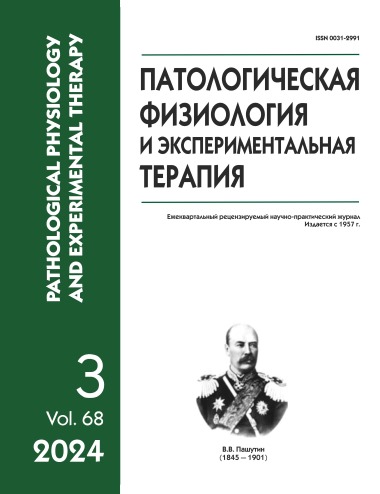S100 protein and tryptophan metabolites in rheumatoid arthritis
Abstract
Introduction. To date, many links in the pathogenesis of rheumatoid arthritis remain unclear, which leads to unsatisfactory results in its therapy. The aim of the research. Study of S100 protein changes and tryptophan metabolites in rheumatoid arthritis.
Мethods. Experiments were performed on 40 WISTAR rats. At baseline, an intraperitoneal injection of type 2 collagen solution (Chondrex, Inc., USA) in Freund's incomplete adjuvant was performed on each animal of the experimental groups. The tissues were tryptophan, kynurenine, 3-hydroxenurinine, L-5-hydrotryptophan by HPLC with fluorimetric and spectrophotometric detection. The S100 protein was determined by streptavidin-biotin-peroxidase. Chemokine concentrations of C-X-C motif chemokine ligand 1 (CXCL1) and chemokine (C-C motif) ligand 2 (CCL2) were determined using Rat Inflammation Panel V02 multiplex assay kits (Biolegend, USA). using a Cytomics FC500 flow cytofluorimeter (Beckman Coulter, USA). Statistical analysis was performed using Jamovi version 2.3.
Results. It was found that the content of CXCL1 increases sharply in the early stages of experimental rheumatoid arthritis, the concentration of CCL2 was high throughout the experiment. The level of S100 protein was consistently high in this pathology. With experimental rheumatoid arthritis, the content of tryptophan metabolites along the kynurenine pathway increases and the concentration of metabolites along the serotonin pathway decreases. Direct positive correlations of the S100 protein with the content of tryptophan metabolites along the kynurenine pathway and negative ones along the serotonin pathway were established.
Conclusions. S100 protein, chemokines, and tryptophan metabolites play important roles in the pathogenesis of rheumatoid arthritis.
Downloads
References
2. Carnazzo V., Redi S., Basile V et al. Calprotectin: two sides of the same coin. U.Rheumatology (Oxford). 2024 Jan 4. 63(1). 26-33. doi: 10.1093/rheumatology/kead405.
3. Manfredi M., Van Hoovels L., Benucci M. et al. Circulating Calprotectin (cCLP) in autoimmune diseases. Autoimmun Rev. 2023 May. 22(5). 103295. doi: 10.1016/j.autrev.2023.103295.
4. Lu Z.F., Hsu C.Y., Younis N.K. et al. Exploring the significance of microbiota metabolites in rheumatoid arthritis: uncovering their contribution from disease development to biomarker potential. APMIS. 2024 Mar 12. doi: 10.1111/apm.13401.
5. Ogbechi J., Clanchy F.I., Huang Y.S. et al. IDO activation, inflammation and musculoskeletal disease.Exp Gerontol. 2020 Mar. 131. 110820. doi: 10.1016/j.exger.2019.110820.
6. Šteigerová M., Šíma M., Slanař O. Pathogenesis of Collagen-Induced Arthritis: Role of Immune Cells with Associated Cytokines and Antibodies, Comparison with Rheumatoid Arthritis. Folia Biol (Praha). 2023. 69(2). 41-49. doi: 10.14712/fb2023069020041.
7. Ghafouri-Fard S., Shahir M., Taheri M., Salimi A. A review on the role of chemokines in the pathogenesis of systemic lupus erythematosus. Cytokine. 2021 Oct. 146. 155640. doi: 10.1016/j.cyto.2021.155640.
8. Moadab F., Khorramdelazad H., Abbasifard M. Role of CCL2/CCR2 axis in the immunopathogenesis of rheumatoid arthritis: Latest evidence and therapeutic approaches. Life Sci. 2021 Mar 15. 269. 119034. doi: 10.1016/j.lfs.2021.119034.
9. Chen W., Fang Y., Wang H. et al. Role of chemokine receptor 2 in rheumatoid arthritis: A research update.Int Immunopharmacol. 2023 Mar. 116. 109755. doi: 10.1016/j.intimp.2023.109755. I
10. Zeng J., Liu X., Liu J. et al. Linkage of calprotectin with inflammation, activity and treatment response of rheumatoid arthritis: a meta-analysis. Biomark Med. 2022 Dec. 16(17). 1239-1249. doi: 10.2217/bmm-2022-0216.
11. Mangoni A.A., Zinellu A. A systematic review and meta-analysis of the kynurenine pathway of tryptophan metabolism in rheumatic diseases. Front Immunol. 2023 Oct 23. 14. 1257159. doi: 10.3389/fimmu.2023.1257159.
12. Bykov Yu.V. Dysfunction of the melatoninergic system in the pathogenesis of diabetes mellitus. Pathological Physiology and Experimental Therapy, Russian Journal. 2023; 67(4): 73-78. doi: 10.25557/0031-2991.2023.04.73-78 (in Russian)
13. Panfili E., Gerli R., Grohmann U., Pallotta M.T. Amino Acid Metabolism in Rheumatoid Arthritis: Friend or Foe? Biomolecules. 2020 Sep. 10(9). 1280. doi: 10.3390/biom10091280.
14. Brock J., Basu N., Schlachetzki J.C.M. et al. Immune mechanisms of depression in rheumatoid arthritis. Nat Rev Rheumatol. 2023 Dec. 19(12). 790-804. doi: 10.1038/s41584-023-01037-w.
15. Fefelov A.A., Bayaskhalanova C.B., Tereshkov P.P. et al. Morphological and immunological tissue changes in experimental periodontitis in rats. Trans-Baikal Medical Bulletin. 2023; № 1: 74-81. doi:: 10.52485/19986173_2023_1_74 (In Russian).
16. Wu Y.Y., Li X.F., Wu S. et al. Role of the S100 protein family in rheumatoid arthritis.Arthritis Res Ther. 2022 Jan 31;24(1):35. doi: 10.1186/s13075-022-02727-8.
17. Bartikoski B.J., De Oliveira M.S., Do Espírito Santo R.C. et al. A Review of Metabolomic Profiling in Rheumatoid Arthritis: Bringing New Insights in Disease Pathogenesis, Treatment and Comorbidities. Metabolites. 2022 Apr 27;12(5):394. doi: 10.3390/metabo12050394.






